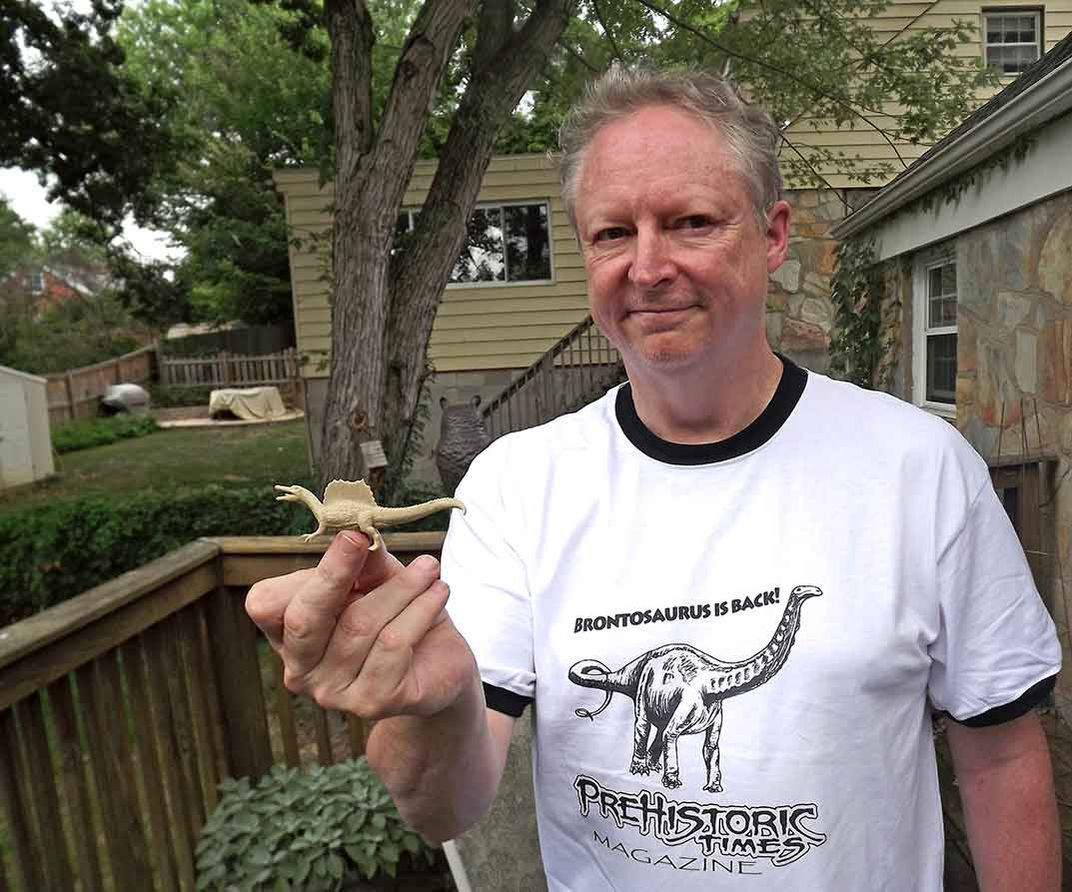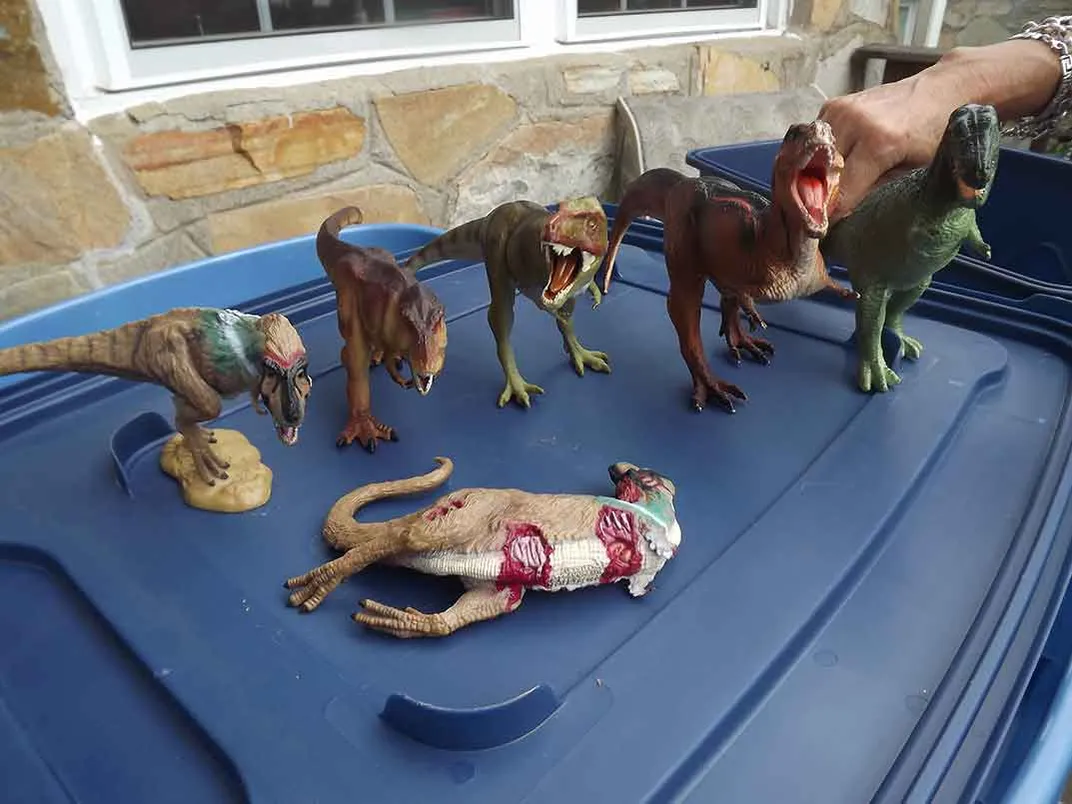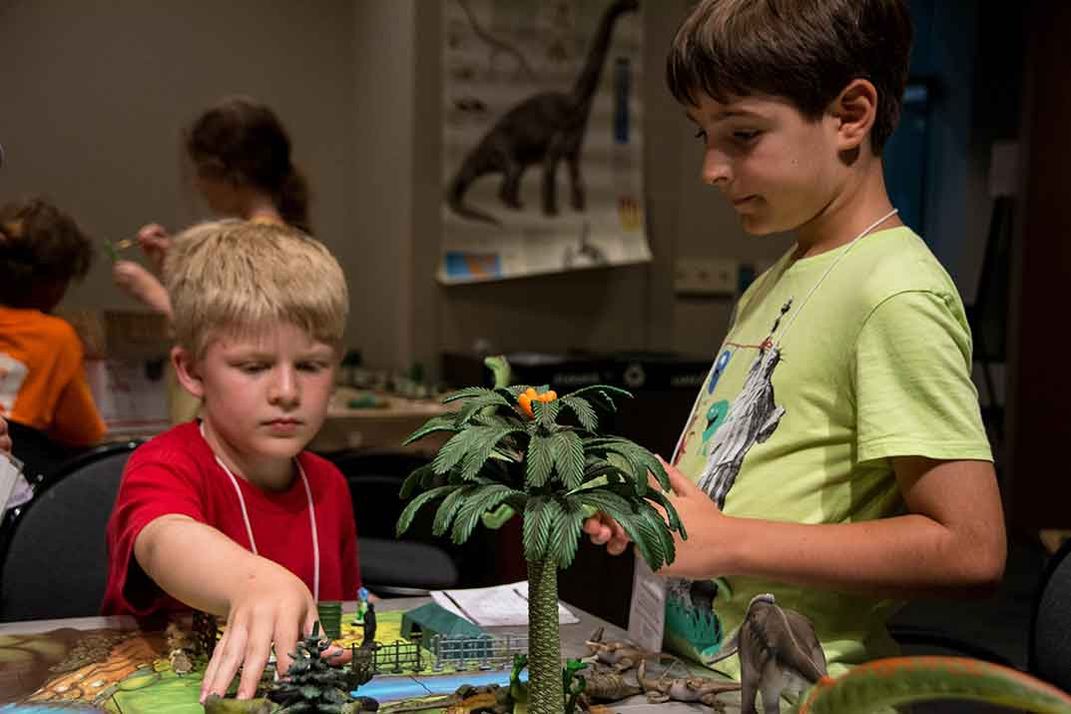This Man Claims He Has the World’s Largest Collection of Toy Dinosaurs, and He Loves Them All
Randy Knol’s stunning array chronicles our evolving knowledge about the prehistoric beasts
/https://tf-cmsv2-smithsonianmag-media.s3.amazonaws.com/filer/89/06/8906562c-e1a5-49ac-87ab-3e46c003da22/374web.jpg)
Randy Knol doesn't know how many toy dinosaurs he has.
It is hard to tell exactly. They aren't all in one place. Most of them are in the basement and the attic. Stacked in boxes, bags and giant Rubbermaid containers. A few have strayed into the kitchen, which is supposed to be off-limits. Bags of the latest arrivals are spread out on the coffee table. More are spread out on the deck behind his house. A tiny rubber triceratops peeks out from under the couch. I didn't go into the bathroom.
Little white brontosauruses from the 1950s with their tails dragging on the ground. A waist-high, anatomically correct sauropod with life-like wrinkles. A Jurassic Park-branded hadrosaurus, still in the original box. Literal six packs of velociraptors. Think of any toy dinosaur from your childhood; Knol has it.
Some of the dinosaurs also leave his collection. Knol teaches summer classes for Smithsonian Associates on building dinosaur dioramas; he supplies the dinos and the kids take those home. He's got the credentials for the job. He's a columnist with the popular magazine Prehistoric Times, dedicated to dinosaur enthusiasts and he is a member of the Society of Vertebrate Paleontology. (His day job is with the U.S. Census Bureau.)
The massive collection began when Knol was a child in the 1960s. “My grandfather gave me a 'Flintstones' playset for Christmas,” he says of the popular television series featuring Fred Flintsone and his pet dinosaur. Both the toys and Knol's appetite for knowledge have increased ever since.

Today, Knol possesses what he thinks is the world's largest collection of toy dinosaurs. How large? “Probably about five or six thousand,” Knol guessed. “I knew a couple of collectors who had more but they're all dead now. I saw their collections show up on eBay. That's how you know they've left the world.”
“My wife accuses me of being a hoarder,” says Knol as he sorts through a cardboard box filled with hundreds of figures that his students had jumbled together. “That's ok, I don't mind. They're not supposed to be in the kitchen any more. I used to have a diorama in the top of the kitchen but periodically dinosaurs would fall on top of her while she was cooking and she didn't like that.”
Knol's family may have a little extra patience with his hobby because of the higher purpose associated with it.
Knol says toy dinosaurs educate children about paleontology and other fields of science when they are well-made. Usually they aren't, which perpetuates a 70-year-old feedback loop of misinformation.
“Most [toy dinosaurs] were driven by popular art” when they first appeared on the market in the 1950s, Knol says. “In the United States, the most influential piece of art at the time was by a man named Zallinger who did the Yale Peabody mural. And if you look at it, most of these figures were directly copied from the mural.”
Rudolph Zallinger's 110-foot-long mural The Age of Reptiles was groundbreaking when it was completed in 1947. It was the first major work of art depicting recreations of what dinosaurs might have looked like when they were alive. A close-up of the mural ran on the cover of Life magazine in 1953 and the artwork quickly became the gold standard for what dinosaurs really looked like. Toymakers cribbed designs from Zallinger's work, as did editors and illustrators of educational books for adults and children.
The problem was that Zallinger's mural was painted at a time when scientists didn't really know very much about dinosaurs or the world that they lived in.
“When I was a kid, plate tectonics did not exist [as a scientific field],” Knol says. “The idea that at the end of the Mesozoic, a comet or giant asteroid hit, that was controversial. The idea that dinosaurs are ancestral to birds, nobody had believed that. Birds were supposed to just be some kind of cousin.”
In 1947, nobody knew that most theropod dinosaurs (these were the ones that mostly walked around on two feet rather than all four) probably had feathers. They were thought of as slow-moving, monochromatic, tail-dragging, cold-blooded lizards.
Today, scientists generally agree that these ideas were wrong. The imagined T. Rex of the 1940s resembles the reconstructed T. Rex of today about as much as a domestic cow resembles a bison. All the same parts are technically present, but the final effect is very different.
Despite decades of new research, more toys continue to be made from the old molds. Educational books for children continue to be illustrated with images based on those toys and past artwork, including Zallinger's mural (which is still prominently featured at the Yale Peabody Museum). And then the images in the books drive demand for the flawed toys. A few companies are trying to make more accurate models but the market has resisted them.

“I was talking to the Safari Company, who've I've known for years,” says Knol. “They were very progressive. They put out a brand new T. Rex that didn't drag its tail or anything. Retailers insisted that they keep the old one because it still sold better. And because what is in all the childrens books? They don't have feathers, they don't have their tails up the air! The kids want things that look like the books that their parents are giving them to read.”
Knol carefully chooses the toys used for his diorama classes. He specially orders models that represent up-to-date science (the kids will paint them in colors according to their own imagination, though). While playing with models is fun, accurate science is at the heart of the entire program. Kids learn about geology, climatology, ecology, biomechanics and botany along the way.
“We visit the [United States] Botanic Garden every year with the kids. One of the things we teach the kids is the difference between spores and seeds. We teach the differences between gymnospores and flowering plants. One of the big issues with using plants in dinosaur dioramas was that you couldn't use grasses because they didn't exist. Well, it turns out that they did.”
The classes are offered as part of a summer camp offered annually by Smithsonian Associates. Exposure to good science at Smithsonian's camps seems to be paying long-term dividends, according to Brigitte Blachere, program manager at the organization. “Some of these kids have come back as college students and done internships with certain scientists,” she says.

“Smithsonian has been presenting summer camps for about 45 years now,” says Blachere. “Randy has been a big part of that at least for the last 15 years.”
The Smithsonian Associates Summer Camp program offers one and two week programs geared towards specific interests. Other Associates programs include courses focused on gardening, modern art, robots and diorama classes focused on famous conflicts such as the Battle of the Somme and the Mexican-American War.
The military diorama classes were what brought Knol and his incredible dinosaur collection to Smithsonian in the first place.
“My son was taking a class for the military stuff,” says Knol, “and I was talking to the guy who did the dioramas. I said that I do dioramas, too, but I mostly do dinosaur stuff. He said we desperately want a dinosaur diorama class. . .and that was over ten years ago and I've been doing it ever since.”
Knol lined up six examples of T. Rex figures for comparison. “This isn't something you should really teach with, but it still seems to sell pretty well,” he says as he holds an upright, featherless, green T. Rex that looks like something out of the 1933 version of King Kong. Several others had a bird-like posture but their feet were oversized (to help the toy stand up). Only two have feathers and sinewy, hawk-like legs. One of these lies twisted and dead on the ground with chunks of flesh torn away to reveal bones and intestines within.
Truly realistic toy dinosaurs are hard to find and often expensive. The two most accurate of the T. Rexes, both made by Collecta, retail for around $30. Highly collectable discontinued models, such as Knol's prized diplodocus, sculpted by Dan LoRusso and made in 1994 by Battat for the Boston Museum of Science, can fetch up to $600 on eBay. Quality and scientific accuracy are highly valued by the community of adult collectors, if less so by parents buying toys for their children.
Even the dinosaurs carried by the gift shops at some museums are usually suspect. “It's all trash,” Knol says. “They are low-end... My favorite was the triceratops that only had one horn.”
“Science is really important,” says Knol. “Getting people interested, especially young people interested in science is important. …there's almost no branch of science that I can't teach while showing kids stuff with dinosaurs. Everything from plate tectonics to why asteroids hit the earth and what the solar system looks like. When we're looking for creative ways to teach kids, let's do it through gamification and introduce these things while having fun rather than doing these death-by-Power-Point lectures that turn everyone off.”
There is something to be learned even from the inaccurate toy dinosaurs with their dragging tails and reptilian postures, according to Knol.
“Science is not just measuring factoids; it's really the whole process of 'we had this information and we thought this, and now we have this other piece of information, so now we think these other things.' ...there's a lot of science ignorance today. Dinosaurs are a nice way of making people literate about science.”
Knol hopes that his life's work will not suffer the same fate as the previous records for the world's largest collection. He would like to see it displayed in a museum, but there is currently no institution prepared to display over 5,000 toy dinosaurs.
“My son has promised to bury it with me but my daughter and my wife will put it all on eBay.”
/https://tf-cmsv2-smithsonianmag-media.s3.amazonaws.com/accounts/headshot/JacksonLanders.jpg)


/https://tf-cmsv2-smithsonianmag-media.s3.amazonaws.com/accounts/headshot/JacksonLanders.jpg)